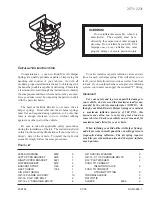
155
9
Practical information
301_en_Chap09_info-pratiques_ed01-2014
Driving advice
Distribution of loads
F
Distribute the load in the trailer so that the
heaviest items are as close as possible to
the axle and the nose weight approaches the
maximum permitted without exceeding it.
Air density decreases with altitude, thus
reducing engine performance. Above
1 000 metres, the maximum towed load must
be reduced by 10 % for every 1 000 metres of
altitude.
Side wind
F
Take into account the increased sensitivity
to side wind.
Cooling
Towing a trailer on a slope increases the
temperature of the coolant.
As the fan is electrically controlled, its cooling
capacity is not dependent on the engine speed.
F
To lower the engine speed, reduce your
speed.
The maximum towed load on a long incline
depends on the gradient and the ambient
temperature.
In all cases, keep a check on the coolant
temperature.
F
If the warning lamp and the
STOP
warning lamp come on,
stop the vehicle and switch off
the engine as soon as possible.
Braking
Towing a trailer increases the braking distance.
To avoid overheating of the brakes on a long
mountain type of descent, the use of engine
braking is recommended.
Tyres
F
Check the tyre pressures of the towing
vehicle and of the trailer, observing the
recommended pressures.
Lighting
F
Check the electrical lighting and signalling
on the trailer.
Refer to the "Technical data" section for details
of the weights and towed loads which apply to
your vehicle.
The rear parking sensors will be
deactivated automatically if a genuine
PEUGEOT towbar is used.
Summary of Contents for 301
Page 1: ...Handbook ...
Page 60: ...58 Fittings Boot fittings 1 Boot lamp 2 Storage box see details on a following page ...
Page 177: ...175 11 Technical data Dimensions in mm ...
Page 210: ...208 ...
Page 236: ......
Page 237: ......
Page 238: ......
















































